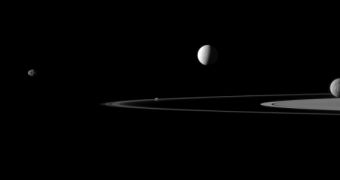This image, collected by the NASA/ESA Cassini space probe on July 29, 2011, showcases five of Saturn's moon, backdropped by the gas giant's beautiful, thin rings. The photo is focused on the Sun-facing side of the rings, while the spacecraft is flying just above the ring plane.
The first object visible on the right is Rhea, the gas giant's second-largest moon. Featuring a diameter of 1,528 kilometers (949.5 miles), the celestial body is located about 1.1 million kilometers (683.509 miles) away from Cassini in this image.
Immediately to the left, and levitating above Saturn's innermost ring, is the moon Mimas, measuring some 400 kilometers (249 miles) across. The luminous, half-eclipsed moon in the center of the image is Saturn's famous icy moon Enceladus, one of the prime candidates in the search for life outside of Earth.
The tiny moon Pandora (81 kilometers / 50 miles across) can be seen flying through Saturn's outermost ring. Farther to the left is the moon Janus, exhibiting some of its many impact craters. These are just 5 of the planet's 62 named satellites.

 14 DAY TRIAL //
14 DAY TRIAL //